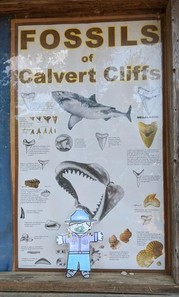
Park Quest Prizes: How to Win
If you complete 12 (or more!) Park Quest activities before Oct. 31 and complete this form, your team will receive an official Park Quest certificate and will be eligible to win Park Quest prizes (proof of completion via photos will be required). The form must be completed by Nov. 1, 2020. Prize drawings will take place on Nov. 2, 2020 at 11 a.m. Winners will be notified by email. Prizes range from Park Quest stickers, magnets and bandanas to an Annual State Park & Trail Passport (valued at $75)
|
New Park Quest activity just added!
Do you just need one more Quest to get to your 12? Try the Trash Timeline Activity!
Wanted: "My MD Ranger" PHOTOS!
We want to see your "My MD Ranger" action photos!
Please email your best shots to Ranger Melissa at melissa.boyle@maryland.gov. You might see your photos used here in our newsletter, on social media, or on our website!
Pictured here is My MD Ranger Sally Sue with the Searching Saunders Park Quest Team, learning all about fossils at Calvert Cliffs State Park.
Print and color your very own “My MD Ranger” to join your team on your Park Quest adventures. If you don’t have access to a printer, create or draw your own ranger with whatever materials you have on hand!
This activity is a "Pick-A-Park" Quest opportunity for 2020!
|
|
 |
Naturalist's Corner: Monarch Migration Time!
The end of the summer season is here and that means it is time to migrate! When you hear the word migrate, you probably think of birds, or maybe even fish, but did you know that monarch butterflies also migrate?
The monarch butterflies that you are seeing here in Maryland during the late summer and early fall will likely spend their winter in Mexico. How do we know that? Well, thanks to a community science program called Monarch Watch, for more than 20 years, scientists, teachers, park rangers, and people like you and me have been “tagging” butterflies by placing a tiny little sticker with letters and numbers on them. Sure enough, the tagged butterflies have been recovered all the way down in Mexico! This data is helping scientists to learn more about monarchs' migration pathways. Only about 1 out of 1,000 monarch butterfly tags are recovered, as it is a long, tough journey to migrate more than 2,000 miles to Mexico. To learn more about some of the challenges to monarch migrations, play the Monarch Migration Mania Game (kids love it!).
Creating Monarch Habitat
If you’d like to see these iconic orange and black butterflies in person, you can visit a nearby state park during migration, or you can encourage the butterflies to visit you!
To entice monarchs into your local gardens, you will need to make sure that you have both the host plant for the caterpillars -- milkweed -- and nectar sources for the adult butterflies. If you plant it, they will come!
Milkweed (Asclepias) is commonly found along roadsides, ditches, and fields throughout most of the state. Monarch caterpillars are pretty picky eaters -- no milkweed means no monarchs! One good practice to provide monarch habitat is waiting to mow areas containing milkweed until after monarchs have left Maryland in the late fall. You can help monarchs out if you plant common milkweed, swamp milkweed (pictured above), or butterfly weed in your garden.
In the fall, to help fuel the adult butterflies for their amazing journey south to Mexico, it is important to have blooming late-season native plants such as asters, ironweed and goldenrod. The nectar from these plants helps to fuel the monarchs as they migrate south. When you see a monarch in Maryland in the fall, wish it well as it makes its way to Mexico for the winter! Learn more about monarch butterflies on the Maryland DNR website.
Creating habitat at home by planting a butterfly garden is one component of the Maryland Park Service’s new Create Your Own State Park Program. Enter your “homegrown” park in our challenge (entry date extended to Nov. 30) and encourage your friends and neighbors to take on the challenge. More butterfly gardens mean more habitat for all sorts of neat critters, including monarch butterfies!
Show off your Park Quest pride!
Check out our online store for Park Quest stickers, bandannas and more.
|